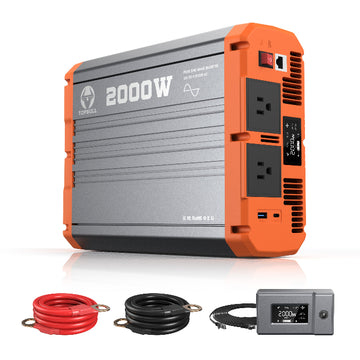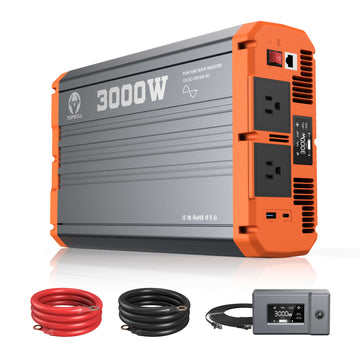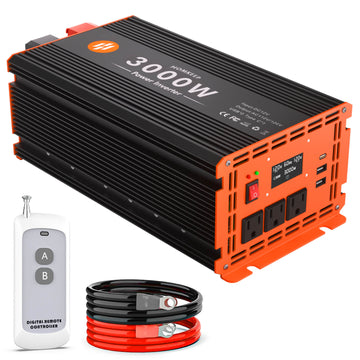As the two main types of inverters, on-grid solar inverters and off-grid solar inverters have their own unique definitions, working principles, features and advantages. This article will compare the differences between on-grid inverters and off-grid inverters in detail to help users make an informed buying decision based on their needs.
On-Grid Inverters
Definition and Working Principle
A on-grid inverter, also known as a grid-connected inverter, is a device used to convert the DC power generated by solar panels into AC power that matches the grid. The basic principle of operation is that when sunlight strikes the panels and generates electricity, the inverter converts the DC power to AC power and feeds it into the grid through the electricity meter. Users can also draw power from the grid when the grid is not providing enough power, thus enabling two-way power management.
Features and Benefits
-
Efficient power generation: On-grid inverters can make full use of solar energy resources and feed excess power into the grid, maximising the use of energy.
-
Economical: Users can sell excess power to the grid through a net metering policy to gain economic returns.
-
No need for energy storage equipment: On grid inverters do not need to be equipped with storage batteries, reducing system costs and maintenance difficulties.
- Grid support: In case of grid failure (anti-islanding protection function is required), the on-grid inverter can quickly cut off the connection with the grid to ensure the safety of personnel and equipment.
Application Scenarios
On-grid inverters are suitable for areas with stable power grids and abundant light resources, and are the mainstream choice for household, industrial and commercial PV systems. It is especially suitable for those who wish to reduce electricity expenses and realise green energy use.
Off-Grid Inverter
Definition and Working Principle
An off-grid inverter, also known as a standalone inverter, is an inverter that is not connected to the public grid. It is responsible for converting the direct current (DC) generated by solar panels into alternating current (AC), which is supplied directly to the local load. Off-grid inverters are usually used in conjunction with storage batteries to ensure a steady supply of power to the load even in low light conditions or at night.
Features and benefits
-
Energy independence: Off-grid inverters realise self-sufficiency in power supply and are not affected by grid failures, improving the reliability and security of energy supply.
-
High flexibility: Users can configure the capacity and number of energy storage batteries according to their own needs to meet the power demand in different scenarios.
- Suitable for remote areas: Off-grid inverters are particularly suitable for remote areas without grid coverage or for scenarios that require complete energy independence.
Application Scenarios
Off-grid inverters are widely used in remote mountainous areas, islands, communication base stations, street lights, and occasions where emergency power is needed. It provides users with a stable power supply and guarantees normal life and work.
On-grid inverters vs. off-grid inverters
Each of these two types of inverters has unique characteristics and application scenarios. Below are their main comparisons:
| Identities | On-grid inverters | Off-grid inverters |
| Power source | Dependence on grid power | Fully independent, dependent on solar power generation and energy storage systems |
| System components | Usually includes inverter and grid connection | Includes inverter, storage battery and load management system |
| Power supply reliability | Unable to supply power during grid outages | Power supply in all conditions |
| costs | Relatively low initial investment, no need to buy batteries | Higher initial investment, including battery and maintenance costs |
| Efficiency | High efficiency and simple system management when the grid is available | Dependence on batteries and energy storage may affect efficiency |
| Usage scenarios | Suitable for urban and commercial buildings, areas with stable power grids | Suitable for remote areas and environments without grid coverage |
| Policy support | Grid subsidies are available | Usually no grid subsidies, relies on user's own investment |
| Power Control | Electricity is sent directly to the grid and used in real time | Battery storage energy for off-grid mode management |
| Inverter type | Mostly single-phase and three-phase inverters | Typically a multi-mode inverter with multiple operating modes |
| Repair and maintenance | Maintenance is relatively simple and focuses on the equipment itself | Includes battery maintenance and requires higher user management capabilities |
Whether to choose on-grid inverter or off-grid inverter
When choosing an inverter, users should make comprehensive consideration based on the following points:
- Consider the grid conditions: if the grid in your region is stable and allows grid-connected power generation, then a on-grid inverter is a more economical choice; if the grid is unstable or cannot be connected to the grid, then an off-grid inverter is more appropriate.
- Evaluating electricity demand: if the user has a large and stable demand for electricity and wants to reduce the cost of electricity, then a on-grid inverter combined with an energy storage system (if required) may be a good choice; if the user's demand for electricity is small and decentralized, or if they need to be completely energy independent, then an off-grid inverter is more suitable.
- Budget and cost: On-grid inverters are usually low-cost and easy to maintain, while off-grid inverters are relatively high-cost and difficult to maintain due to the need to configure storage batteries. Therefore, you need to consider the budget and long-term maintenance cost when purchasing.
- Future development planning: If the user intends to expand the PV system or connect to the grid in the future, then a grid-tied inverter may be more forward-looking; if the user wants to maintain energy independence and relatively stable electricity demand, then an off-grid inverter may be more appropriate.
Hybrid Inverters
In addition to grid-connected and off-grid inverters, users can also consider hybrid inverters. Hybrid inverters combine the advantages of both, grid connection and energy storage, making them suitable for a wide range of applications. Hybrid inverters are particularly suitable for the following users:
Users who want to maintain power supply in case of grid instability: Hybrid inverters can automatically switch to off-grid mode to maintain power supply in case of grid failure.
Customers with renewable energy projects and energy storage needs: These inverters optimize the use of electricity, allowing customers to store energy when electricity prices are low and use the stored power when prices are high.
Customers looking for flexible solutions: the hybrid inverter offers the flexibility to connect to the grid and use off-grid mode, allowing the customer to adjust the power usage pattern according to the actual situation.
Conclusion
When choosing a solar inverter, users need to consider the advantages, disadvantages and scenarios of on-grid inverters, off-grid inverters and hybrid inverters. On-grid inverters are suitable for areas with good grid coverage to optimize electricity bills; off-grid inverters provide independent power supply in remote areas to ensure continuous power supply in the absence of the grid; hybrid inverters combine the advantages of both and provide greater flexibility by automatically switching to off-grid mode when the grid is unstable. Users should make an informed choice based on grid conditions, electricity demand, budget and future development plans, and focus on product quality and performance to ensure the long-term stable operation of the PV system. With the development of solar technology, these three inverters will play a more important role in the energy field.













